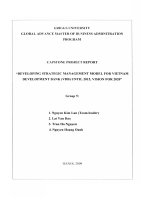Strategic management planning for domestic and global competition 14th ed pearce robinson chapter 3
Bạn đang xem bản rút gọn của tài liệu. Xem và tải ngay bản đầy đủ của tài liệu tại đây (289.56 KB, 34 trang )
Chapter 3
Corporate Social
Responsibility and
Business Ethics
© 2015 by McGraw-Hill Education. This is proprietary material solely for authorized instructor use. Not authorized for sale or distribution in any manner. This document may not be copied, scanned, duplicated, forwarded, distributed, or
posted on a website, in whole or part.
Learning Objectives
1.
2.
3.
4.
5.
6.
7.
8.
Understand the importance of the stakeholder approach
Explain the continuum of social responsibility
Describe a social audit
Discuss the effect of the Sarbanes-Oxley Act
Compare advantages of collaborative social initiatives
Explain the 5 principles of collaborate social initiatives
Compare the merits of different approaches to business ethics
Explain relevance of business ethics to strategic management practice.
2
The Stakeholder Approach to Social Responsibility
According to the Stakeholder Approach:
•
In defining or redefining the company mission, strategic managers must recognize the
legitimate rights of the firm’s claimants.
•
In addition to stockholders and employees, these include outside stakeholders affected
by the firm’s actions.
3
Examples of Stakeholders
•
•
•
•
•
•
•
Customers
Suppliers
Governments
Unions
Competitors
Local communities
General public
4
Steps to Incorporate Stakeholders
1.
2.
3.
4.
Identification of stakeholders
Understanding stakeholders’ specific claims vis-à-vis the firm
Reconciliation of these claims and assignment of priorities
Coordination of the claims with other elements of the company mission
5
The Dynamics of Social Responsibility
•
•
•
•
Inside vs. Outside Stakeholders
Duty to serve society plus duty to serve stockholders
Flexibility is key
Firms differ along:
Competitive Position
Industry
Country
Environmental Pressures
Ecological Pressures
6
Ex. 3.2
Inputs to the Development of Company Mission
7
Types of Social Responsibility
•
•
Economic – the duty of managers, as agents of the company owners, to maximize
stockholder wealth
Legal – the firm’s obligations to comply with the laws that regulate business activities
8
Types of Social Responsibility (contd.)
•
•
Ethical – the company’s notion of right and proper business behavior.
Discretionary – voluntarily assumed by a business organization.
9
Corporate Social Responsibility
•
Corporate social responsibility (CSR), is the idea that business has a duty
to serve society in general as well as the financial interests of
stockholders.
10
CSR and Profitability
•
The dynamic between CSR and success (profit) is complex. They are not mutually exclusive,
and they are not prerequisites of each other.
•
Better to view CSR as a component in the decision-making process of business that must
determine, among other objectives, how to maximize profits.
11
Factors Complicating a Cost-Benefit Analysis of CSR:
1.
2.
3.
4.
Some CSR activities incur no dollar costs at all. In fact, the benefits from
philanthropy can be huge.
Socially responsible behavior does not come at a prohibitive cost.
Socially responsible practices may create savings, and, as a result, increase profits.
Proponents argues that CSR costs are more than offset in the long run by an
improved company image and increased community goodwill.
12
CSR Today
•
•
•
•
Priority of American businesses
Sustainability and the Resurgence of Environmentalism
Increasing Buying Power among Consumers
Globalization of Business
13
Sarbanes-Oxley Act of 2002
•
Law that revised and strengthened auditing and accounting standards.
14
Sarbanes-Oxley Act of 2002 (contd.)
•
•
•
•
•
•
•
CEO and CFO must certify every report containing company’s financial
statements
Restricted corporate control of executives, acting, firms, auditing
committees, and attorneys
Specifies duties of registered public acting firms that conduct audits
Composition of the audit committee and specific responsibilities
Rules for attorney conduct
Disclosure periods are stipulated
Stricter penalties for violations
15
New Corporate Governance Structure
•
•
•
•
Restructuring governance structure in American corporations
Heightened role of corporate internal auditors
Auditors now routinely deal directly with top corporate officials
CEO information provided directly by the company’s chief compliance and chief
accounting officers
16
Ex. 3.12
The New Corporate Governance Structure
17
CSR’s Effect on Mission Statement
•
•
The mission statement embodies what company believes
Managers must identify all stakeholder groups and weigh their
relative rights and abilities to affect the firm’s success
18
Social Audit
•
A social audit is an attempt to measure a company’s actual social
performance against its social objectives.
•
The social audit may be used for more than simply monitoring and
evaluating firm social performance.
19
Satisfying Corporate Social Responsibility
•
•
•
Conflicting pressures on executives
The CSR Debate: centuries old
There are mutual advantages to using Collaborative Social
Initiatives (CSIs)
20
Ex. 3.14
Continuum of Corporate Social Responsibility Commitments
21
Five Principles of Successful CSIs
1.
2.
Identify a Long-Term Durable Mission
Contribute “What We Do”*
*This is the most important principle
3.
4.
5.
Contribute Specialized Services to a Large-Scale Undertaking
Weigh Government’s Influence
Assemble and Value the Total Package of Benefits
22
Five Principles of Successful Corporate Social
Responsibility Collaboration
Ex. 3.15
23
The Limits of CSR Strategies
•
•
•
Some companies have embedded social responsibility and sustainability
commitments deeply in their core strategies.
Larger companies must move beyond the easy options of charitable
donations but also steer clear of overreaching commitments.
CSR strategies can also run afoul of the skeptics—the speed of
information on the Internet makes this an issue with serious
ramifications.
24
The Future of CSR
•
•
CSR is firmly and irreversibly part of the corporate fabric
•
•
The public’s perception of ethics in corporate America is near its all-time low
Corporations will face growing demands for social responsibility contributions far
beyond simple cash or in-kind donations
Even when groups agree on what constitutes human welfare, the means they
choose to achieve it may differ
25









